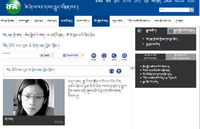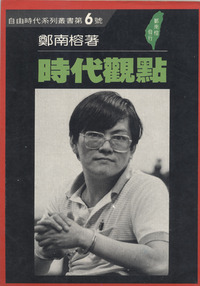2009年12月11日
史伯嶺:「探尋圖伯特歷史與文化」研討會上的致詞
懸鉤子:美國印第安那大學的歐亞研究講座教授、藏學家艾略特‧史伯嶺,最近參加印度德里舉行的「探尋圖伯特歷史文化」研討會,在閉幕式上作了代表致詞。承蒙他的允許,我將之翻譯成中文,也附上英文的原文,與所有關心圖伯特、心向圖伯特文化、在意圖伯特歷史的朋友們一起分享。
另,此次會議在圖伯特時報(Tibet Times)上的報導:http://www.tibettimes.net/news.php?showfooter=1&id=1933
史伯嶺教授文章的博伊(藏文)版:http://www.tibettimes.net/news.php?id=1949

另,此次會議在圖伯特時報(Tibet Times)上的報導:http://www.tibettimes.net/news.php?showfooter=1&id=1933
史伯嶺教授文章的博伊(藏文)版:http://www.tibettimes.net/news.php?id=1949

代表觀察/艾略特‧史伯嶺
聖尊陛下、蘇內佳教授、阿旺桑丹教授、潘達爾教授、各位敬愛的同事與貴賓:
過去三天的研討會裏,我們已經涵蓋了許多主題。我們討論到圖伯特與其近鄰與遠鄰的交流,所到達的地理範圍之遼遠,著實十分可觀;這個小組所討論的主題也一樣令人驚訝,特別對一個長期以來被認為是孤立閉鎖的國家,一個被稱之為種族的文化,而不是一個國家的文化而言(而這個稱謂是圖伯特流亡政府的一些領袖都不反對的字眼。)
我不會再詳細地介紹本研討會的歷史部門所提出來的論文摘要或其名稱,然而我想對這些論文作一個整體的觀察。在這次研討會的過程之中,我們已經讀到與聽到各式的論文與演講,範圍涵蓋了整個圖伯特文化世界,特別是印度-圖伯特的交流互動,與喜馬拉雅以外地區的連繫--當然了,這涵括了錫金、拉達克與所有圖伯特邊界上的其他喜馬拉雅地區。圖伯特與中國的歷史關係--不只是政治上的,還有社會與經濟上的--都在這裏做了有益的探討。一些論文也檢視了圖伯特在十九、二十世紀更大範圍的國際政治關係裏的地位,其中一些論文強調了圖伯特在蒙古與蒙古民族的歷史裏所佔的地位,從忽必烈一直到圖伯特-蒙古條約簽訂為止。確實,本次會議上,針對十七至十八世紀裏,我們也許可以稱為圖伯特-蒙古世界的空間,與這個空間以外,所形成的各種緊密宗教與政治連繫,提出來闡明與解釋的論文數量著實是相當可觀的。而它也不在這裏就停止了,因為該世界也為後來建立清朝的滿洲統治者,保留了一個適得其所的位置。
我們也聽到了新的發現、新的詮釋,讓此次的研討會成為今日典型藏學研究之美好範例。在歷史部份,我們有政治、宗教與政治互動、官僚制度與考古學等等的歷史研究。我們如何評估這些事務的輕重?啊,我們甚至還有一篇傑出的論文,是討論圖伯特度量衡的。
所有的這些,愈來愈多容易取得的博伊史料是至為重要的。過去與現今博巴的理念與想法,寫在紙張上,寫在書本裏,或者以口語表述,就是我們研究的核心。沒有博伊與博蓋的知識,就沒有嚴肅的藏學研究。這一點在印度,甚至在薩拉特‧錢德拉‧達斯(Sarat Chandra Das, 1849-1917)之前的時代,就已被印度的學者所領悟,至今仍為顛撲不破的真理。這次的研討會也突出了這一點。因此,我特別想恭喜我們的東道主,德里大學與藏學中央大學(Central University of Tibetan Studies)(1),藉著此次的研討會,把此點特別突顯出來。
而歷史部份的作品,其研究範圍亦顯示藏學研究不只是佛教研究而已。這並不是要貶低佛教研究的重要性,或者它在我們工作上的地位。但你不必是佛教學者,才能熱情地被藏學所吸引。圖伯特與博巴在科學、藝術與學術上發展出悠遠的傳統,其入門與研究的方式,正如同其他的國家與民族所發展出來的學術與傳統入門與研究的方式一樣,也是我們在此研討會上所見到的。
我很高興在這裏看到年輕的博巴,不管是學生、觀察員或者是工作人員。我以下所說的話,絕大多數都是針對你們而說的。我所說的有關於圖伯特學術的一切、以及掌握博伊史料的必要性,都與你們的遺產有關。非博巴的學者也許對藏學研究非常熱情,但這不是我們的遺產。這是你們的:你們可以擁抱那些偉大的學者與歷史學家已經寫在書本上的遺產--以你們的博伊知識--而藉著閱讀這些書本,讓他們直接對你說話,告訴你們有關於圖伯特的事情,而不是仰賴那些圖伯特支持運動所產生出來的現成英文資料。你們這一代有兩個選擇,一是去掌握你們所繼承的豐富遺產,另一就是任它陵夷敗壞。圖伯特肯定是一個國家;博巴肯定是一個民族。他們與其他的國家與民族共同存在於這個世界上,並且像任何正常的國家與民族一樣,與外界交流互動。圖伯特不是什麼「宇宙靈魂」,除了一些有閒的人可以這樣幻想外。
圖伯特的現代問題,對我們在這裏完成的工作,投下了巨大的陰影。這是無可避免、我們必須面對的事情。從歷史部門的角度發言,我不得不提出,圖伯特議題的戰場之一(也絕對不只一個戰場)就是歷史。最近在中國,自從2008年開始,我們已經見到一個西藏地位重新受到詮釋的版本在流傳:不再是自元朝以來作為中國的一部份,西藏現在是「自人類活動以來」就是中國的了;拉贊普(Lha btsan-po,神聖贊普)的帝國朝代,現在是中國的朝代,與唐朝並駕其驅,並存於中國內部,如同遼、金朝與宋朝並存一樣。
我試圖處理的,是事實:史籍所載不只是敍述而已,還有事實,雖然處理它們、瞭解它們,是永無止境的工作。所以,有一些人來找我,請我在這裏談談讓贊。我--我只代表自己發言,不代表本會場的其他任何人--是否認為圖伯特在歷史上獨立於中國?當然是;這一點我已經多次公開地在正式場合講過,也有白紙黑字紀錄在案。因此,我是否認為目前圖伯特臣屬於中國是對那段歷史的一種侮辱?我的答案是一樣的。而且,我感覺到,圖伯特流亡政權所提出、認為是可行又實際的道路,現在已經被暴露為不可行又不實際的了。所以,我被要求為讓贊說話。我?為什麼不是你們?特別是與當權者坐在一起的你們。現在是你們說話的時候了,不論你們身處於權力的核心,還是位在權力之外,現在都你們心裏想的、嘴巴上講的不再有所區隔的時候了--不再是對這個官員說著 "lags legs-so"(「是」、「遵命」),對著那位喇嘛說 "skyabs-su-mchi"(「好,好」)的時候了。或更糟糕:想著「把這些學者集中在一起,讓他們講一些直接或間接支持讓贊的話,所以我們可以犬儒地說『看我們多麼友善、務實又實際,把學者在這裏證明的事實都可以棄之不顧。』」我自然反對我的作品被有這樣傾向的人用作談判的籌碼。不論是在這裏或在其他地方。
在這裏,有一個綿延無縫的鄉土情深(sems-shugs)的網絡,而它又回到我先前所提起的,關於你們必須掌握那份埋藏在無數古書(dpe-cha)(2)封面封底之間的豐富遺產,它將穿越千古時空直接對你們說話,如果你們打開它們的話。你們的文化遺產、你們的國家遺產,是你們要決定是否要繼承,還是要放棄的。如果是後者,那麼至少不要哀嘆別人缺乏對圖伯特的支持。
此時我想要說幾句感謝的話。這裏有許多工作人員是我想個別感謝的--他們的工作十分傑出,也對我們非常照顧。等一下會有人針對大會致謝詞,我不會掠人之美。但我想要特別提起德里大學的迪巴克‧潘達爾教授、藏學中央大學的阿旺桑丹教授,感謝他們合作無間,創造出這個激發創意、成果豐碩的研討會議。我們該為此次了不起的聚會而感謝你們。而我也覺得我有必要感謝此次研討會的「電子郵件代表人」:卓瑪。而最後一位,是我們許多人的老朋友,強巴桑丹教授,他除了在鹿野苑的職務與研究工作之外,還為了此次研討會擔任了許多工作。在德里受到強巴的迎接,是一件讓人喜悅的事情,而我希望他覺得他此次的任務已經圓滿達成。我肯定這樣覺得。
譯註:
(1):藏學中央大學,原名Central Institute of Higher Tibetan Studies,是一所1967年成立於印度瓦拉那西鹿野苑(Sarnath, Varanasi, India)的高等學府。目前此大學由阿旺桑丹教授所領導,致力於藏學、佛學、喜馬拉雅研究。
(2):Dpe-cha是傳統的圖伯特古籍,一般是寫在長方形的印度紙張上。又譯「經典」、「經文」。


Delegate Observation
by Elliot Sperling
Your Holiness, Prof. Suneja, Prof. Ngawang Samten, Prof. Pental, Respected Colleagues and Guests
There are many topics that we have covered over the last three days. The geographical reach of Tibet’s interactions with near neighbors and far neighbors that we have discussed has been considerable; the subjects which this group has discussed are equally amazing, especially for a nation long considered isolated and a culture that is termed (and it’s a term to which some even in the exile Tibetan leadership don’t object) an ethnic rather than a national culture.
I won’t go into a summary or list of the papers heard in the history section of the conference, but I would like to make some general observations about them as a whole. Over the course of this conference we have seen and heard presentations and papers that cover the expanse of the Tibetan cultural world most obviously Indo-Tibetan interactions and ties beyond the Himalayas—including, of course, Sikkim as well as Ladakh and the other Himalayan areas across the Tibetan border. Tibet’s historical relations with China—not simply political but also social and economic—have been discussed very profitably here. Some papers have examined Tibet’s place in the larger world of 19th and 20th century power politics, while a number of papers have underlined Tibet’s role in the history of Mongolia and the Mongols, from the time of Sečen Qubilai right through the conclusion of the Tibeto-Mongol Treaty. Indeed, the number of papers that have cast light on an array of intimate links, religious and political, that created a space we might term the Tibeto-Mongol world of the 17th-18th centuries and beyond is striking. But it doesn’t stop there, for that world also had a niche for the Manchu rulers who established the Qing Empire.
We have heard new findings and new interpretations that have made of this conference a wonderful example of all that is typical of Tibetan Studies today. In the History Section we have had contributions on history as it relates to politics, the interaction of religion and politics, bureaucracy, archeology and more. How to weigh the value of all this? Well we’ve also had a distinguished paper on Tibetan weights and measures.
In all this, the expanding world of accessible Tibetan sources has been shown to be crucial. The expression of Tibetans in the past and today, committed to books and paper or declared orally is the core of what we do. Without the ability to work in Tibetan there is no serious Tibetan Studies. This was grasped in India even before the time of Sarat Chandra Das and it remains true today. This seminar has made it obvious. I would like to therefore congratulate our hosts, the University of Delhi and the Central University of Tibetan Studies for bringing this out via our conference.
As the range of work in the History Section also demonstrates, Tibetan Studies is not simply Buddhist Studies. This is not to denigrate the study of Buddhism or its place in what we do. But one doesn’t need to be a Buddhologist to be drawn passionately to Tibetan Studies. Tibet and Tibetans have evolved traditions in the sciences, the arts and in scholarship that are approachable in the way that those of other nations and peoples are approachable, as we have seen here.
I am gratified to see young Tibetans here, either as students, observers, or staff. Most of what I have to say from this point on is really directed at you. All that I’ve said about Tibetan scholarship and the necessity of grasping Tibetan sources relates to your heritage. Passionate as non-Tibetan scholars might be about Tibetan Studies, this is not our patrimony. It is yours: you can embrace the legacy that great Tibetan scholars and historians have committed to books—in Tibetan—and by reading them let them speak directly to you and tell you things about Tibet that you won’t get from the ready-made English-language materials that come out of the Tibet-support movement. It is for your generation to grasp the wealth of your inheritance or to let it rot. Tibet is assuredly a nation; Tibetans are assuredly a people. They are situated among other nations and peoples and have interacted with them as nations and peoples do. Tibet is not some “world soul,” save for those who have the leisure to fantasize along such lines
The modern question of Tibet looms over what we have done here. That’s a fact of life. Speaking from the standpoint of the History Section, I cannot but note that one—and not only one—of the battlegrounds of the Tibet Issue is history. Most recently in China, since 2008, we have seen the circulation of a revised interpretation of Tibet’s status: no longer a part of China since the Mongol era, Tibet has now been part of China “since human activity began,” and the imperial dynasty of the Lha btsan-po is now a Chinese Dynasty, coexisting within China next to the Tang as the Liao and Jin Dynasties coexisted in China next to the Song.
I try to deal with facts: there are not just narratives, there are facts, though dealing with and understanding them is work that is without end. And so a few people here have come to me and asked that I speak here about Rangzen. Well do I—and I speak now for myself and not for anyone else in this room—think that Tibet was historically independent of China? Of course; I’m well on record about that. Do I think that therefore the current situation of Tibetan subjugation to China is an insult to that history? The answer is the same. Moreover I perceive that the path that Tibet’s exile authorities have laid out as practical and realistic is now exposed as impractical and unrealistic. And so I’ve been asked to speak for Rangzen. Me? What about you, especially those of you who sit alongside authority. It is for you to speak, inside and outside the councils of power, with no difference between what’s in the heart and what’s on the tongue—and not simply to say lags legs-so to this bureaucrat and skyabs-su-mchi to that lama. Or worse: to think, “gather all these scholars, have them say things that directly or indirectly support Rangzen so as to cynically say ‘look at how conciliatory, practical and realistic we are, rendering irrelevant what scholars have shown to be the case.’” I certainly object to my work being used as a bargaining chip by those inclined to do so. Here or elsewhere.
There’s a seamless web of sems-shugs here and it goes back to my remarks about the need for you to grasp that rich legacy that lies between the countless covers of countless dpe-cha that will speak to you directly, across centuries if you’ll open them. Your cultural legacy and your national legacy are for you to pick up or to let go. If it’s the latter, then at least please don’t lament anyone else’s lack of support for Tibet.
I would like at this point to say a few words of thanks. There are too many people on staff for me to thank individually—their work has been spectacular and they’ve taken excellent care of us. And there will be a vote of thanks upon which I don’t want to intrude. But I’d like to mention Profs. Deepak Pental and Ngawang Samten of the University of Delhi and the Central University of Tibetan Studies respectively, for the cooperative venture that produced this stimulating and productive conference. We are all in your debt for this marvelous gathering. And I feel a need to thank the person who became the public “e-mail face” of the conference, Dolma. And finally an old friend of many of us, Prof. Jampa Samten, who in addition to his duties and research in Sarnath, took on so much of the work of the conference. It was a pleasure to be welcomed to Delhi by Jampa and I hope he feels his work was successful. I certainly do.
聖尊陛下、蘇內佳教授、阿旺桑丹教授、潘達爾教授、各位敬愛的同事與貴賓:
過去三天的研討會裏,我們已經涵蓋了許多主題。我們討論到圖伯特與其近鄰與遠鄰的交流,所到達的地理範圍之遼遠,著實十分可觀;這個小組所討論的主題也一樣令人驚訝,特別對一個長期以來被認為是孤立閉鎖的國家,一個被稱之為種族的文化,而不是一個國家的文化而言(而這個稱謂是圖伯特流亡政府的一些領袖都不反對的字眼。)
我不會再詳細地介紹本研討會的歷史部門所提出來的論文摘要或其名稱,然而我想對這些論文作一個整體的觀察。在這次研討會的過程之中,我們已經讀到與聽到各式的論文與演講,範圍涵蓋了整個圖伯特文化世界,特別是印度-圖伯特的交流互動,與喜馬拉雅以外地區的連繫--當然了,這涵括了錫金、拉達克與所有圖伯特邊界上的其他喜馬拉雅地區。圖伯特與中國的歷史關係--不只是政治上的,還有社會與經濟上的--都在這裏做了有益的探討。一些論文也檢視了圖伯特在十九、二十世紀更大範圍的國際政治關係裏的地位,其中一些論文強調了圖伯特在蒙古與蒙古民族的歷史裏所佔的地位,從忽必烈一直到圖伯特-蒙古條約簽訂為止。確實,本次會議上,針對十七至十八世紀裏,我們也許可以稱為圖伯特-蒙古世界的空間,與這個空間以外,所形成的各種緊密宗教與政治連繫,提出來闡明與解釋的論文數量著實是相當可觀的。而它也不在這裏就停止了,因為該世界也為後來建立清朝的滿洲統治者,保留了一個適得其所的位置。
我們也聽到了新的發現、新的詮釋,讓此次的研討會成為今日典型藏學研究之美好範例。在歷史部份,我們有政治、宗教與政治互動、官僚制度與考古學等等的歷史研究。我們如何評估這些事務的輕重?啊,我們甚至還有一篇傑出的論文,是討論圖伯特度量衡的。
所有的這些,愈來愈多容易取得的博伊史料是至為重要的。過去與現今博巴的理念與想法,寫在紙張上,寫在書本裏,或者以口語表述,就是我們研究的核心。沒有博伊與博蓋的知識,就沒有嚴肅的藏學研究。這一點在印度,甚至在薩拉特‧錢德拉‧達斯(Sarat Chandra Das, 1849-1917)之前的時代,就已被印度的學者所領悟,至今仍為顛撲不破的真理。這次的研討會也突出了這一點。因此,我特別想恭喜我們的東道主,德里大學與藏學中央大學(Central University of Tibetan Studies)(1),藉著此次的研討會,把此點特別突顯出來。
而歷史部份的作品,其研究範圍亦顯示藏學研究不只是佛教研究而已。這並不是要貶低佛教研究的重要性,或者它在我們工作上的地位。但你不必是佛教學者,才能熱情地被藏學所吸引。圖伯特與博巴在科學、藝術與學術上發展出悠遠的傳統,其入門與研究的方式,正如同其他的國家與民族所發展出來的學術與傳統入門與研究的方式一樣,也是我們在此研討會上所見到的。
我很高興在這裏看到年輕的博巴,不管是學生、觀察員或者是工作人員。我以下所說的話,絕大多數都是針對你們而說的。我所說的有關於圖伯特學術的一切、以及掌握博伊史料的必要性,都與你們的遺產有關。非博巴的學者也許對藏學研究非常熱情,但這不是我們的遺產。這是你們的:你們可以擁抱那些偉大的學者與歷史學家已經寫在書本上的遺產--以你們的博伊知識--而藉著閱讀這些書本,讓他們直接對你說話,告訴你們有關於圖伯特的事情,而不是仰賴那些圖伯特支持運動所產生出來的現成英文資料。你們這一代有兩個選擇,一是去掌握你們所繼承的豐富遺產,另一就是任它陵夷敗壞。圖伯特肯定是一個國家;博巴肯定是一個民族。他們與其他的國家與民族共同存在於這個世界上,並且像任何正常的國家與民族一樣,與外界交流互動。圖伯特不是什麼「宇宙靈魂」,除了一些有閒的人可以這樣幻想外。
圖伯特的現代問題,對我們在這裏完成的工作,投下了巨大的陰影。這是無可避免、我們必須面對的事情。從歷史部門的角度發言,我不得不提出,圖伯特議題的戰場之一(也絕對不只一個戰場)就是歷史。最近在中國,自從2008年開始,我們已經見到一個西藏地位重新受到詮釋的版本在流傳:不再是自元朝以來作為中國的一部份,西藏現在是「自人類活動以來」就是中國的了;拉贊普(Lha btsan-po,神聖贊普)的帝國朝代,現在是中國的朝代,與唐朝並駕其驅,並存於中國內部,如同遼、金朝與宋朝並存一樣。
我試圖處理的,是事實:史籍所載不只是敍述而已,還有事實,雖然處理它們、瞭解它們,是永無止境的工作。所以,有一些人來找我,請我在這裏談談讓贊。我--我只代表自己發言,不代表本會場的其他任何人--是否認為圖伯特在歷史上獨立於中國?當然是;這一點我已經多次公開地在正式場合講過,也有白紙黑字紀錄在案。因此,我是否認為目前圖伯特臣屬於中國是對那段歷史的一種侮辱?我的答案是一樣的。而且,我感覺到,圖伯特流亡政權所提出、認為是可行又實際的道路,現在已經被暴露為不可行又不實際的了。所以,我被要求為讓贊說話。我?為什麼不是你們?特別是與當權者坐在一起的你們。現在是你們說話的時候了,不論你們身處於權力的核心,還是位在權力之外,現在都你們心裏想的、嘴巴上講的不再有所區隔的時候了--不再是對這個官員說著 "lags legs-so"(「是」、「遵命」),對著那位喇嘛說 "skyabs-su-mchi"(「好,好」)的時候了。或更糟糕:想著「把這些學者集中在一起,讓他們講一些直接或間接支持讓贊的話,所以我們可以犬儒地說『看我們多麼友善、務實又實際,把學者在這裏證明的事實都可以棄之不顧。』」我自然反對我的作品被有這樣傾向的人用作談判的籌碼。不論是在這裏或在其他地方。
在這裏,有一個綿延無縫的鄉土情深(sems-shugs)的網絡,而它又回到我先前所提起的,關於你們必須掌握那份埋藏在無數古書(dpe-cha)(2)封面封底之間的豐富遺產,它將穿越千古時空直接對你們說話,如果你們打開它們的話。你們的文化遺產、你們的國家遺產,是你們要決定是否要繼承,還是要放棄的。如果是後者,那麼至少不要哀嘆別人缺乏對圖伯特的支持。
此時我想要說幾句感謝的話。這裏有許多工作人員是我想個別感謝的--他們的工作十分傑出,也對我們非常照顧。等一下會有人針對大會致謝詞,我不會掠人之美。但我想要特別提起德里大學的迪巴克‧潘達爾教授、藏學中央大學的阿旺桑丹教授,感謝他們合作無間,創造出這個激發創意、成果豐碩的研討會議。我們該為此次了不起的聚會而感謝你們。而我也覺得我有必要感謝此次研討會的「電子郵件代表人」:卓瑪。而最後一位,是我們許多人的老朋友,強巴桑丹教授,他除了在鹿野苑的職務與研究工作之外,還為了此次研討會擔任了許多工作。在德里受到強巴的迎接,是一件讓人喜悅的事情,而我希望他覺得他此次的任務已經圓滿達成。我肯定這樣覺得。
譯註:
(1):藏學中央大學,原名Central Institute of Higher Tibetan Studies,是一所1967年成立於印度瓦拉那西鹿野苑(Sarnath, Varanasi, India)的高等學府。目前此大學由阿旺桑丹教授所領導,致力於藏學、佛學、喜馬拉雅研究。
(2):Dpe-cha是傳統的圖伯特古籍,一般是寫在長方形的印度紙張上。又譯「經典」、「經文」。


Delegate Observation
by Elliot Sperling
Your Holiness, Prof. Suneja, Prof. Ngawang Samten, Prof. Pental, Respected Colleagues and Guests
There are many topics that we have covered over the last three days. The geographical reach of Tibet’s interactions with near neighbors and far neighbors that we have discussed has been considerable; the subjects which this group has discussed are equally amazing, especially for a nation long considered isolated and a culture that is termed (and it’s a term to which some even in the exile Tibetan leadership don’t object) an ethnic rather than a national culture.
I won’t go into a summary or list of the papers heard in the history section of the conference, but I would like to make some general observations about them as a whole. Over the course of this conference we have seen and heard presentations and papers that cover the expanse of the Tibetan cultural world most obviously Indo-Tibetan interactions and ties beyond the Himalayas—including, of course, Sikkim as well as Ladakh and the other Himalayan areas across the Tibetan border. Tibet’s historical relations with China—not simply political but also social and economic—have been discussed very profitably here. Some papers have examined Tibet’s place in the larger world of 19th and 20th century power politics, while a number of papers have underlined Tibet’s role in the history of Mongolia and the Mongols, from the time of Sečen Qubilai right through the conclusion of the Tibeto-Mongol Treaty. Indeed, the number of papers that have cast light on an array of intimate links, religious and political, that created a space we might term the Tibeto-Mongol world of the 17th-18th centuries and beyond is striking. But it doesn’t stop there, for that world also had a niche for the Manchu rulers who established the Qing Empire.
We have heard new findings and new interpretations that have made of this conference a wonderful example of all that is typical of Tibetan Studies today. In the History Section we have had contributions on history as it relates to politics, the interaction of religion and politics, bureaucracy, archeology and more. How to weigh the value of all this? Well we’ve also had a distinguished paper on Tibetan weights and measures.
In all this, the expanding world of accessible Tibetan sources has been shown to be crucial. The expression of Tibetans in the past and today, committed to books and paper or declared orally is the core of what we do. Without the ability to work in Tibetan there is no serious Tibetan Studies. This was grasped in India even before the time of Sarat Chandra Das and it remains true today. This seminar has made it obvious. I would like to therefore congratulate our hosts, the University of Delhi and the Central University of Tibetan Studies for bringing this out via our conference.
As the range of work in the History Section also demonstrates, Tibetan Studies is not simply Buddhist Studies. This is not to denigrate the study of Buddhism or its place in what we do. But one doesn’t need to be a Buddhologist to be drawn passionately to Tibetan Studies. Tibet and Tibetans have evolved traditions in the sciences, the arts and in scholarship that are approachable in the way that those of other nations and peoples are approachable, as we have seen here.
I am gratified to see young Tibetans here, either as students, observers, or staff. Most of what I have to say from this point on is really directed at you. All that I’ve said about Tibetan scholarship and the necessity of grasping Tibetan sources relates to your heritage. Passionate as non-Tibetan scholars might be about Tibetan Studies, this is not our patrimony. It is yours: you can embrace the legacy that great Tibetan scholars and historians have committed to books—in Tibetan—and by reading them let them speak directly to you and tell you things about Tibet that you won’t get from the ready-made English-language materials that come out of the Tibet-support movement. It is for your generation to grasp the wealth of your inheritance or to let it rot. Tibet is assuredly a nation; Tibetans are assuredly a people. They are situated among other nations and peoples and have interacted with them as nations and peoples do. Tibet is not some “world soul,” save for those who have the leisure to fantasize along such lines
The modern question of Tibet looms over what we have done here. That’s a fact of life. Speaking from the standpoint of the History Section, I cannot but note that one—and not only one—of the battlegrounds of the Tibet Issue is history. Most recently in China, since 2008, we have seen the circulation of a revised interpretation of Tibet’s status: no longer a part of China since the Mongol era, Tibet has now been part of China “since human activity began,” and the imperial dynasty of the Lha btsan-po is now a Chinese Dynasty, coexisting within China next to the Tang as the Liao and Jin Dynasties coexisted in China next to the Song.
I try to deal with facts: there are not just narratives, there are facts, though dealing with and understanding them is work that is without end. And so a few people here have come to me and asked that I speak here about Rangzen. Well do I—and I speak now for myself and not for anyone else in this room—think that Tibet was historically independent of China? Of course; I’m well on record about that. Do I think that therefore the current situation of Tibetan subjugation to China is an insult to that history? The answer is the same. Moreover I perceive that the path that Tibet’s exile authorities have laid out as practical and realistic is now exposed as impractical and unrealistic. And so I’ve been asked to speak for Rangzen. Me? What about you, especially those of you who sit alongside authority. It is for you to speak, inside and outside the councils of power, with no difference between what’s in the heart and what’s on the tongue—and not simply to say lags legs-so to this bureaucrat and skyabs-su-mchi to that lama. Or worse: to think, “gather all these scholars, have them say things that directly or indirectly support Rangzen so as to cynically say ‘look at how conciliatory, practical and realistic we are, rendering irrelevant what scholars have shown to be the case.’” I certainly object to my work being used as a bargaining chip by those inclined to do so. Here or elsewhere.
There’s a seamless web of sems-shugs here and it goes back to my remarks about the need for you to grasp that rich legacy that lies between the countless covers of countless dpe-cha that will speak to you directly, across centuries if you’ll open them. Your cultural legacy and your national legacy are for you to pick up or to let go. If it’s the latter, then at least please don’t lament anyone else’s lack of support for Tibet.
I would like at this point to say a few words of thanks. There are too many people on staff for me to thank individually—their work has been spectacular and they’ve taken excellent care of us. And there will be a vote of thanks upon which I don’t want to intrude. But I’d like to mention Profs. Deepak Pental and Ngawang Samten of the University of Delhi and the Central University of Tibetan Studies respectively, for the cooperative venture that produced this stimulating and productive conference. We are all in your debt for this marvelous gathering. And I feel a need to thank the person who became the public “e-mail face” of the conference, Dolma. And finally an old friend of many of us, Prof. Jampa Samten, who in addition to his duties and research in Sarnath, took on so much of the work of the conference. It was a pleasure to be welcomed to Delhi by Jampa and I hope he feels his work was successful. I certainly do.
Posted by rosaceae at 02:46
│史伯嶺教授











